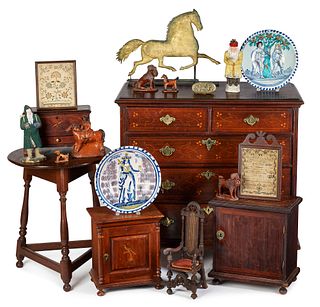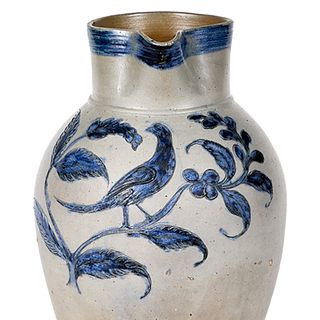Handmade Stonewares & Crocks – An Americana Pottery Tradition
Pottery is emerging as the new-age mindfulness mantra in the Western world, where fast-paced urban life paves way for awareness of slow living. Many are rethinking on the lines of going back to basics. From learning to bake one’s own bread to growing one’s own vegetables in the kitchen garden, people are learning to reconnect with roots. It’s all about looking beyond instant gratification, an underlining aspect of the present-day lifestyles. Pottery aptly fits this exercise of relooking our vacuous way of life. Things can’t be rushed and this is the most important takeaway from pottery. Perhaps our wise ancestors knew this well. The best lessons of life arose from their kilns in the process of hand making and crafting each piece of clay.

Jar by Katherine (Kathy) Pino, Zia Pueblo, New Mexico, ca. 1970 | On view in the Elizabeth M. and Joseph M. Handley Gallery - Colonial Williamsburg
Pottery in the Americas
American folk pottery, including a vast variety of stoneware and crockerpots, is a slice of an enriching earthy experience. Just like other folk art forms, American pottery emerged from the utilitarian needs of everyday life. In North America, pottery began more than 1,000 years before its advent in Mexico. Archeologists discovered ceramic pots dating back to 2,890 BCE in the Savannah River valley in Georgia and South Carolina, whereas cooking vessels from the Norwood and Orange in Florida belong to 2,460 BCE. Interestingly, the origins of pottery trace back to the practice of using cooking baskets. To make the woven casing baskets durable, the tribal communities began lining them with mud clay. This is evident from archeological excavations of ancient clay pots, which revealed textures and indentions from a basket. When wood coals were heated and dropped in the basket to cook the food, they found that the heat hardened the clay. They soon realized mud pots alone were good enough for cooking.
Coiling is the most widely used technique of handcrafting ceramics historically. Rolled into thin, long strands, coiled one upon another, each pot was handcrafted without the use of wheel. Handmade by women folk of the aboriginal communities, the coils are blended together, leaving no trace of demarcation or deviation in thickness. Hohokam potters of the Southwest America used paddle-and-anvil technique. The interior wall of a pot was reinforced by an anvil, whereas the exterior was beaten with a paddle to flatten the surface.
Lot 88, An Exceptional Pennsylvania Free-Hand Cobalt Decorated 4 Gallon Crock
Stoneware – A Staple of American Households
The term “stoneware” is a bit of a misnomer as it has nothing to do with stone. It is in fact made of a specific type of clay obtained from varied deposits found across different regions. Stoneware pottery is robust, nonporous and durable. Some varieties of modern stoneware can actually resist the heat generated in a microwave. One of the reasons for the popularity of stoneware is that it distributes heat evenly when compared with other pottery types making it a favorite material for coffee mugs and tea cups!
Colonial potters in the Americas took to salt glazing stoneware around the end of 18th century. Also known as vitrification, this process makes the pottery resistant to acidic foods and water. Before the pots are fired, salt is thrown in large quantities inside the kiln. At temperature above 2,000 - 2,400 degrees Fahrenheit, salt vaporizes and coats the pottery with a colorless glassy finish.
Utility items such as stoneware jugs, bottles and crock pots were used regularly in daily cooking, preservation and transportation of food items. Everyday objects including stoneware pitchers, crocks, jars, mugs, milk pans, butter churns, bowls and foot warmers were handcrafted with a sense of simplicity and resourcefulness. What makes these forms so distinctive is that even though they serve a utilitarian purpose, they also offer a handcrafted, timeless aesthetic. Today, Americana pottery has evolved from an object of storage into a symbol of cultural heritage with flags, bunting and other representations of liberty and democracy commonly adorning many antique stoneware crocks.
Lot 436, Four Cobalt Decorated Pennsylvania Stoneware Crocks and a Jar
Pottery in America – Traversing Regions & Traditions
The migration of settlers expanded the production of pottery in America with many potter communities migrating from New England down into Pennsylvania, Virginia, and North Carolina. An ongoing exhibition at the Abby Aldrich Rockefeller Folk Art Museum in Virginia highlights the folk art pottery of women and men whose artistic skills continue to inspire the contemporary generations of potters in America.
Incorporated in 1847, the Somerset Potters Works was set up by brothers Benjamin and Clark Chace. Displayed at the exhibition is a cooler from their stoneware kiln. It has a distinguishing stamp ornamentation of birds and branches. It is noteworthy that stamped beautification is more commonly found in New York State than New England. A late 19th century flowerpot/urn exhibited at the museum bears a Bell Pottery stamp and was crafted under the ownership of Samuel Bell and his sons. The Bell family is well-known for its earthenware and stoneware in the Valley of Virginia. Lion mask handles and foliate spots and accents are some of the décor features that are characteristic of Bell Pottery house. A 20th century large storage jar from the kiln of a North Carolina-based potter with roots in Germany and Pennsylvania also highlights the display. Interestingly, the four-handled style has a close connection with Catawba Valley stoneware.
A storage jar produced by Webster family depicts incised motifs of geometric and figural designs. It is crafted by Edward and Chester, nephews of the McCloud Webster (Webster School of Folk Potters). The nephews had moved to North Carolina from Connecticut and carried their beautification techniques along. The Webster family members worked at several pottery factories in Connecticut. They acquired the skills of making salt-glazed stoneware with incised decoration, a technique popularly found in English stoneware culture.
Lot 38, Baltimore stoneware pitcher, ca. 1825, attributed to Henry Remmey Jr. or Sr
Identifying Antique Stoneware Designs
The best way to identify antique stoneware is with its rustic look and feel. The old stoneware often has a shiny surface, resembling glass, with tiny bumps of salt particles. Etchings in clay were done with cobalt blue color. Floral motifs, trees and birds were some of the most common depictions. Another significant identification of its value and age is the maker's mark, which could be a logo, symbol, an alphabet or for that matter the manufacturer’s name. The stamp can often be found at the bottom of the object.
The pottery scene in America was once replete with 200 studios and umpteen small factories. However, many of the kilns were compelled to shut down eventually owing to stiff competition from commercialization. The beginning of World War I and the following Great Depression were some of the other critical factors. Nevertheless, the stoneware pottery tradition has created a rich legacy of craftsmanship. It stirred interests in modernist aesthetics and a host of influential personalities in the world of American art pottery, including the likes of Maria Longworth Nichols and Frederick Hurten Rhead.
- A Buyer’s Guide to Diamonds: Understanding the 4 Cs
- Artist Spotlight: KAWS, A Contemporary Icon of Street Art and Collecting
- The Golden Art of Ormolu: A History of Gilded Brilliance
- Winter Landscapes, Lineage & Modern Expression
- Artist Spotlight: David Gerstein, Sculptural Pop in Bold Color & Motion
- The History of Rolex Watches: Innovation, Precision, and Enduring Prestige
- Preview the December Doyle+Design Auction: A Celebration of Modern & Contemporary Mastery
- Billings Winter Design 2025: A Celebration of Modern Mastery Across Eras
- The Ultimate Holiday Gift Guide: Luxe Finds From Bidsquare’s Finest Auctions
- Fine & Antique Jewelry Sale: A Curated Journey Through Craftsmanship & Design



 EUR
EUR CAD
CAD AUD
AUD GBP
GBP MXN
MXN HKD
HKD CNY
CNY MYR
MYR SEK
SEK SGD
SGD CHF
CHF THB
THB.jpg)
.jpg)
.jpg)













